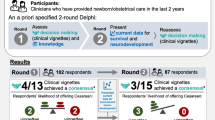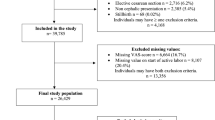Abstract
Objective
To evaluate the association of patient preferences and attitudes with TOLAC.
Study design
Prospective observational study of TOLAC-eligible women at 26–34 weeks gestation. Preferences (utilities) were elicited using the time trade-off and standard gamble metrics. Logistic regression was used to identify preference- and attitude-based factors associated with TOLAC.
Results
Of the 231 participants, most (n = 197, 85%) preferred vaginal delivery, but only 40% (n = 93) underwent TOLAC. Utilities for uterine rupture outcomes did not differ based on delivery approach. In multivariable analysis, strength of preference for vaginal delivery, value for the experience of labor, and the opinion of the person whom the participant thought of as most important to this decision were associated with TOLAC.
Conclusions
Future decision support interventions incorporating individualized information regarding the likelihood of vaginal birth and empowering patients to express their preferences and engage their families in the decision-making process may improve decision quality and increase TOLAC rates.
This is a preview of subscription content, access via your institution
Access options
Subscribe to this journal
Receive 12 print issues and online access
$259.00 per year
only $21.58 per issue
Buy this article
- Purchase on Springer Link
- Instant access to full article PDF
Prices may be subject to local taxes which are calculated during checkout
Similar content being viewed by others
Change history
10 October 2019
An amendment to this paper has been published and can be accessed via a link at the top of the paper.
References
Martin JA, Hamilton BE, Osterman MJK, Driscoll AK, Matthews TJ. Births: Final data for 2015. National vital statistics report; vol 66, no 1. Hyattsville, MD: National Center for Health Statistics; 2017.
National Vital Statistics Reports. Births: Final Data for 2017. ftp://ftp.cdc.gov/pub/Health_Statistics/NCHS/Dataset_Documentation/DVS/natality/UserGuide2015.pdf accessed 4/30/17.
Guise J-M, Eden K, Emeis C, Denman MA, Marshall N, Fu R, et al. Vaginal birth after cesarean: new insights. Evidence report/Technology assessment no.191. (prepared by the Oregon Health & Science University Evidence-based Practice Center under contract no. 290-2007-10057-I). AHRQ publication no. 10-E003. Rockville, MD: Agency for Healthcare Research and Quality; 2010.
Grobman WA, Lai Y, Landon MB, Spong CY, Rouse DJ, Varner MW, et al. The change in the rate of vaginal birth after caesarean section. Paediatr Perinat Epidemiol. 2011;25:37–43.
American College of Obstetricians and Gynecologists. ACOG Practice Bulletin No. 115: Vaginal birth after previous cesarean delivery. Obstet Gynecol. 2010;116(2 Pt 1):450–63.
Wu J, Fulton R, Amundsen C, Knight S, Kuppermann M. Patient preferences for different severities of and treatments for overactive bladder. Female Pelvic Med Reconstr Surg. 2011;17:184–9.
Yee LM, Kaimal AJ, Houston KA, Wu E, Thiet MP, Nakagawa S, et al. Mode of delivery preferences in a diverse population of pregnant women. Am J Obstet Gynecol. 2015;212:377.e1–24.
Wu E, Kaimal AJ, Houston K, Yee LM, Nakagawa S, Kuppermann M. Strength of preference for vaginal birth as a predictor of delivery mode among women who attempt a vaginal delivery. Am J Obstet Gynecol. 2014;210:440.e1–6.
Rutter D, Quine L. Social cognition models and changing health behaviours. In: Rutter D, Quine L, editors. Changing health behaviour intervention and research with social cognition models. Buckingham: Open University Press; 2002.
Ajzen I. Attitudes, personality and behavior. Milton Keynes: Open University Press; 1988.
Grobman WA, Lai Y, Landon MB, Spong CY, Leveno KJ, Rouse DJ, et al. National Institute of Child Health and Human Development (NICHD) Maternal-Fetal Medicine Units Network (MFMU), “Development of a nomogram for prediction of vaginal birth after cesarean delivery,” Obstet and Gynecol. 2007;109: 806–12.
Vittinghoff E, McCulloch CE. Relaxing the rule of ten events per variable in logistic and cox regression. Am J Epidemiol. 2007;165:710–8.
Kaimal AJ, Kuppermann M. Understanding risk, patient and provider preferences, and obstetric decision making: approach to delivery after cesarean. Semin Perinatol. 2010 34:331–6.
McMahon MJ, Luther ER, Bowes WA Jr, Olshan AF. Comparison of a trial of labor with an elective second cesarean section. N Engl J Med. 1996;335:689–95.
Grobman WA, Lai Y, Landon MB, Spong CY, Leveno KJ, Rouse DJ, et al. Eunice Kennedy Shriver National Institute of Child Health and Human Development Maternal-Fetal Medicine Units Network. Can a prediction model for vaginal birth after cesarean also predict the probability of morbidity related to a trial of labor? Am J Obstet Gynecol. 2009;200:56.e1–6.
Chaillet N, Bujold E, Dubé E, Grobman WA. Validation of a prediction model for predicting the probability of morbidity related to a trial of labour in Quebec. J Obstet Gynaecol Can. 2012;34:820–5.
Stewart BM, Weston W, McWHinney I, et al. Patient-centered medicine: transforming the clinical method. London: Sage Publications; 1995.
Legare F, O’Connor AC, Graham I, Saucier D, Cote L, Cauchon M, et al. Supporting patients facing difficult health care decisions: use of the Ottawa Decision Support Framework. Can Fam Physician. 2006;52:476–7.
Funding
This work was supported by NIH/NICHD R01 HD078748 (PI Kuppermann).
Author information
Authors and Affiliations
Contributions
All authors certify that they made substantial contributions to the conception or design of the work (AK, WG, AB, PB, and MK); or the acquisition, analysis, or interpretation of data for the work (AK, WG, AB, PB, MK, CB, JG, MPT, and YB); and Drafted the work or revising it critically for important intellectual content (AK, WG, AB, PB, MK, CB, JG, MPT, and YB); and Gave final approval of the version to be published (AK, WG, AM, PB, MK, CB, JG, MPT, and YB); and Agree to be accountable for all aspects of the work in ensuring that questions related to the accuracy or integrity of any part of the work are appropriately investigated and resolved. (AK, WG, AM, PB, MK, CB, JG, MPT, and YB).
Corresponding author
Ethics declarations
Conflict of interest
The authors declare that they have no conflict of interest.
Additional information
Publisher’s note: Springer Nature remains neutral with regard to jurisdictional claims in published maps and institutional affiliations.
Rights and permissions
About this article
Cite this article
Kaimal, A.J., Grobman, W.A., Bryant, A. et al. The association of patient preferences and attitudes with trial of labor after cesarean. J Perinatol 39, 1340–1348 (2019). https://doi.org/10.1038/s41372-019-0399-5
Received:
Revised:
Accepted:
Published:
Issue Date:
DOI: https://doi.org/10.1038/s41372-019-0399-5
This article is cited by
-
Application of a specific clinical pathway can affect the choice of trial of labor in patients with a history of cesarean delivery
BMC Pregnancy and Childbirth (2024)
-
“Because it eases my Childbirth Plan”: a qualitative study on factors contributing to preferences for caesarean section in Thailand
BMC Pregnancy and Childbirth (2023)
-
Patient decision aid for trial of labor after cesarean (TOLAC) versus planned repeat cesarean delivery: a quasi-experimental pre-post study
BMC Pregnancy and Childbirth (2021)



